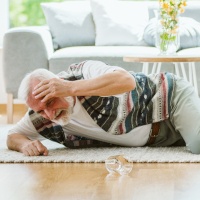
At some point in our lives, nearly all of us will take a tumble—off a ladder, a curb, a bike—but rarely with lasting consequences. However, when older adults have a fall, the aftermath can be devastating. According to the Centers for Disease Control and Prevention (CDC), 30 million older adults fall each year, resulting in some 30,000 deaths, making falls the leading cause of fatal injury for adults age 65 and older.
But even just the act of falling—with or without injury—can significantly lower quality of life for seniors. As the National Council on Aging notes, fear of having another fall can lead older adults to avoid activities like walking, shopping, and socializing, which can lead to depression, social isolation, increased immobility, and a sense of helplessness.
My husband witnessed this firsthand when his grandmother fell and broke her hip. After she came home from the hospital, she never left her wheelchair. Although her health had been good before her fall, she declined quickly and passed away just two months later.
Download Our Free Guide: When to Consider Assistance for My Loved One
Conditions that Can Cause Falls
My father had severe peripheral arterial disease (PAD) which made walking painful and difficult for him. As he become more sedentary, he lost strength in his legs. One day, everything came together in a perfect storm: I had dropped him off in front of the pharmacy to go park the car. Less than a minute later, I was horrified to find him face down on the pavement, bleeding from his forehead. Fortunately, there were no broken bones, but the experience was traumatic for both of us. It also made me more aware of the factors that can cause falls.
The CDC highlights the following conditions as risk factors:
- Difficulties with walking and balance
- Lower body muscle weakness
- Vitamin D deficiency
- Medications that may affect balance (e.g., tranquilizers, sedatives, or antidepressants)
- Vision problems
- Unstable footwear
- Foot pain
- Tripping hazards, like uneven stairs, throw rugs, clutter, or even pets
Taking Steps to Reduce Falls
Even though the risk of falling does increase as we get older, falls are not an inevitable part of aging. It might not be possible to eliminate every fall risk factor, but there are several steps you can take to help your loved one stay upright, active, and independent:
- Consult with their doctor: Get an evaluation of their fall risk and ask for recommendations on ways to stay safe. Find out if any of their medications (prescription and over-the-counter) could make them dizzy or sleepy. Check with their doctor about adding a vitamin D supplement to improve bone and muscle health.
- Build strength and balance: Request a referral for physical therapy to help your family member learn basic exercises to strengthen their legs and improve their balance. Another great option is Tai Chi or yoga classes, either at their senior residence or at a community center. They might feel weak at first but encourage them to keep at it—with practice, they will get stronger!
- Schedule an eye exam: Your loved one should have their eyes checked by an ophthalmologist at least once a year and, if needed, get new eyeglasses. An annual eye exam can detect glaucoma and cataracts, conditions that limit vision. If they wear bifocals or progressive lenses, consider ordering a second pair of glasses with only their distance prescription to use for activities like walking.
- Make home a safe zone: Lifesprk nurses and home health aides have helped thousands of Twin Cities’ seniors live more independently with simple adjustments—like:
- Removing small throw rugs or using double-sided tape to keep them from slipping
- Adding grab bars inside and outside the tub or shower and next to the toilet
- Placing non-slip rubber mats in the tub or shower
- Installing railings on both sides of stairs
- Replacing dim light bulbs with brighter ones.
- Another important tip: make sure their shoes fit well and don’t slip
If your family member has experienced a fall, consider working with a senior care company, like Lifesprk who supports seniors in the Twin Cities and surrounding Minnesota counties, both for your loved one’s peace of mind and for yours. Lifesprk’s unique whole-person approach encompasses all aspects of well-being, not just physical health, to help older adults live happier, healthier, and more independent lives.
Wondering where to start? Download our free guide which gives you a great starting point for understanding when you should consider assistance for your loved one and the next steps you can take to maintain their independence long-term. For immediate support, schedule a free consultation and learn how Lifesprk can help your loved one live a sparked life.




